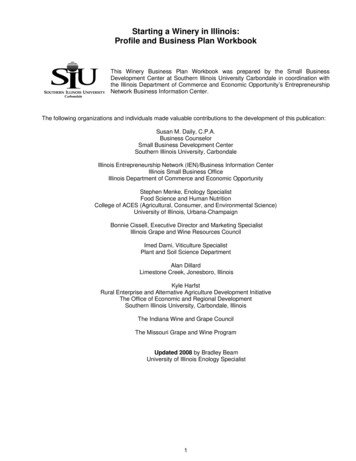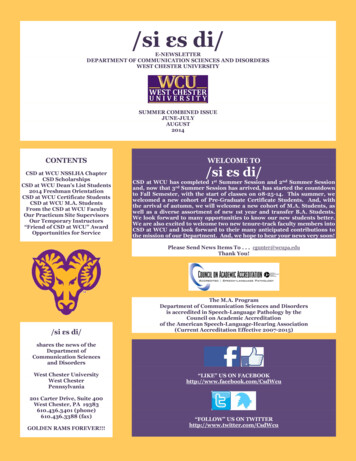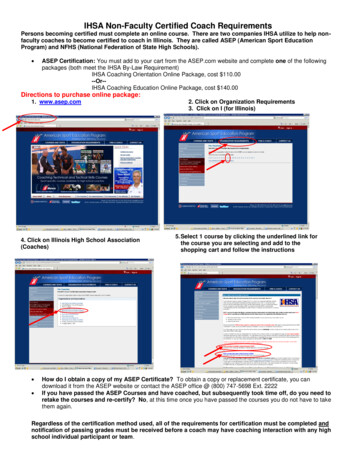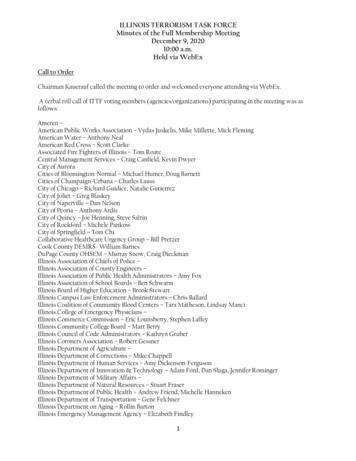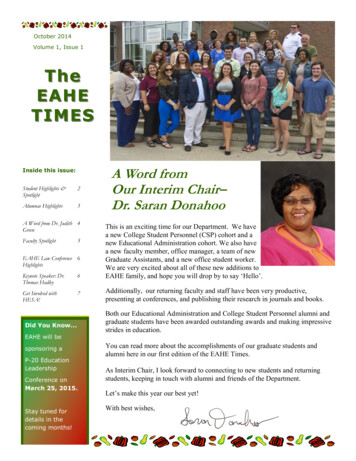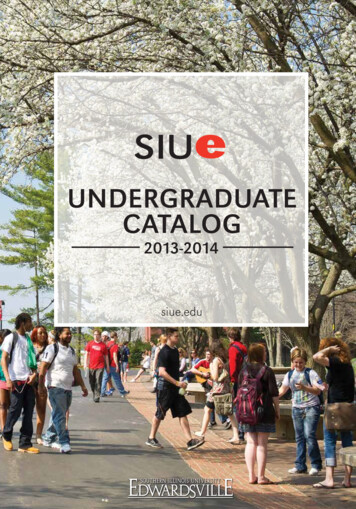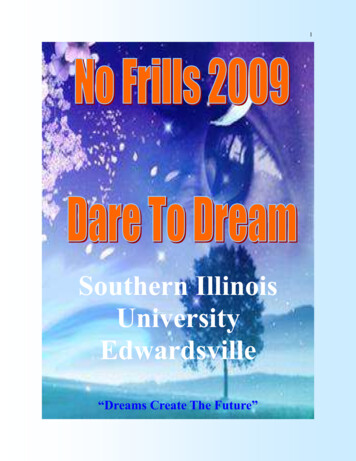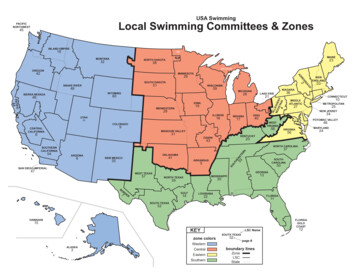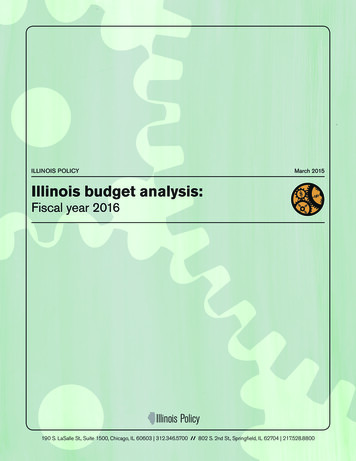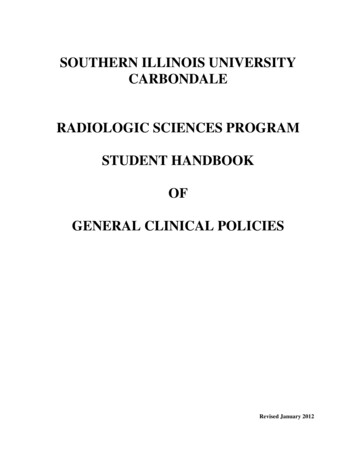
Transcription
SOUTHERN ILLINOIS UNIVERSITYCARBONDALERADIOLOGIC SCIENCES PROGRAMSTUDENT HANDBOOKOFGENERAL CLINICAL POLICIESRevised January 2012
TABLE OF CONTENTSCHAPTER 1 - IntroductionWelcome and Purpose of Handbook. 5Mission and Focus StatementsSIUC Focus Statement . 5ASA Mission Statement . 6Radiologic Sciences Program Mission Statement .6Professional Organizations and Opportunities . . 7Career Mobility . 8Professional Ethics . 9ARRT Standards of Ethics . 10Rules of Ethics . . 10SIUC University Student Conduct Code . . 11CHAPTER 2 - Student InformationClinical Site Assignments . . .12Hospital Orientation . 12Clinical Drug Screen . 13School Calendar . 14Student Expenses . 14Books . 14Housing . 14Liability Insurance. 14Transportation . 14Tuition .14Uniforms . 15RADS Program Dress Code . . 15Student Health Program . 17Student Records . 17RADS Health Record . 17Professional Observations . 18Grading System . 18Library Privileges . 19Registry Exam . 19Student Grievance Procedures . 20Academic Grievance . 20Academic Probation and Suspension . . 20Unsatisfactory Progress . 20Clinical Grievance . . 20Clinical Probation . 20Clinical Suspension . 20Sexual Harassment Policy. 21Attendance Policy . 24Inclement Weather Policy .24Bereavement Leave.24Financial Aid Day.25Request for Time Off . 262RADSTDNTHBK-GenPol 01/2012
University Holidays . 26Communicable/Infectious Disease Policy .27Insurance, Accidents and Incidents . 27Medical Insurance . 27Incidents and Accidents . 27CHAPTER 3 - Professional BehaviorGeneral Statement . 30Steps in Professional Behavior . 30HIPAA. . . 31Safety Practices for Pregnant Radiation Workers & Students . 32APPENDIX A: Professional Ethics . 36ARRT Standards of EthicsRules of EthicsAPPENDIX B: SIUC Student Conduct Code . 38Acts of Academic DishonestyActs of Social MisconductSanctions and ConditionsAPPENDIX C: Hospital and Department Orientations . 43Hospital OrientationClinical Drug ScreenCriminal Background CheckRadiology Department OrientationAPPENDIX D: Grievance Procedures . 47Academic GrievanceClinical GrievanceStudent Grievance AppealClinical Supervisor Grievance AppealUnsatisfactory ProgressAcademic Probation and SuspensionClinical Probation and SuspensionAPPENDIX E: University Policy--Sexual Harassment . . 52APPENDIX F: Infectious Disease PoliciesSIUC Policy Statement on AIDS . 61School of Allied Health & RADS Policy. 63APPENDIX G: Incident Report FormInstructions for Completing University Injury Report . 69University Injury/Incident/Hazard Report . 703RADSTDNTHBK-GenPol 01/2012
APPENDIX H: Health Claims to Student Health CenterSubmitting a Claim to University Health Services . . 72APPENDIX I: Pregnancy PolicyPregnancy Radiography Student . 74SIUC RADS Pregnancy Policy . 77Pregnancy Status Declaration . 79APPENDIX J: Liability Insurance . 81APPENDIX K: Professional AppearanceDress Code Compliance Form . 83This clinical handbook consists of two separate sections: general policies common to allmodalities in the Radiologic Sciences Program in the front; and, the specific clinicaleducation policies for a specific modality in the back.4RADSTDNTHBK-GenPol 01/2012
CHAPTER 1--INTRODUCTION AND PROGRAM GOALSWELCOMEWelcome to the Radiologic Sciences Program. You are entering a paramedical careerprogram that is interesting, diversified, and demanding. The program is designed to help youdevelop the knowledge and skills required to perform in a specialized area. Many subtlequalities besides knowledge and skills are required to complete the program successfully. Animportant personal quality that will be closely evaluated throughout your training is your abilityto relate with the patient and to provide both physical and emotional support to the patient.Another quality or trait is your ability to work as part of a team and interact successfully withdepartment and hospital personnel. Weaknesses spotted in any area of performance will beexpected to be resolved promptly. Counseling will be arranged if problems are significant.The Radiologic Sciences faculties wish you success in the Program. We are here to assistyou in pursuing your newly chosen profession.PURPOSE OF HANDBOOKThis handbook is designed to serve as in informational guide to assist in the orientation ofnew students and to clarify policies and procedures governing your actions and practices while astudent in Radiologic Sciences. It is expected that the Radiologic Sciences students will befamiliar with the following information.SOUTHERN ILLINOIS UNIVERSITY FOCUS STATEMENTSouthern Illinois University Carbondale offers a full range of baccalaureate programs, iscommitted to graduate education through the doctoral degree, and gives high priority to research.It receives substantial federal support for research and development and annually awards asignificant number of doctoral degrees balanced among selected liberal arts and sciencesdisciplines and professional programs. In addition to pursuing statewide goals and priorities,Southern Illinois University Carbondale: strives to develop the professional, social, and leadership skills expected of collegestudents and to improve student retention and achievement; supports the economic, social, and cultural development of southern Illinois throughappropriate undergraduate, graduate, and professional education and research; develops partnerships with communities, businesses, and other colleges and universities,and develops utilization of telecommunication technologies;5RADSTDNTHBK-GenPol 01/2012
cultivates and sustains a commitment in research and instruction to problems and policyissues related to the region and the state’s natural resources and environment; strives to meet the health care needs of central and southern Illinois through appropriatehealth-related programs, services, and public health policy; and, cultivates and sustains diversity through a commitment to multiculturalism, includinginternational programming.MISSION STATEMENT OF THE COLLEGE OF APPLIED SCIENCES AND ARTSThe College of Applied Sciences and Arts seeks to inspire and cultivate vision throughpersonal involvement of students with faculty toward achieving technical expertise for success ina diverse and changing society.RADIOLOGIC SCIENCES PROGRAM MISSION STATEMENTThe faculty and staff of the Radiologic Sciences Program provide students theopportunity and resources to enable them to obtain entry-level competencies, recognizingindividual differences and needs. We provide an environment that enhances critical thinking,professional behaviors, and life-long learning for the benefit of students, community and theprofession. To meet this Mission, the goals of the Program are:1.To provide the students with a course of study which will enable them to qualifyto take the American Registry Examination in Radiography, and the advancedmodalities.2.To provide the southern Illinois area health care facilities with a continual sourceof qualified radiographers.3.To provide the student with accurate information concerning employmentopportunities.4.To continually evaluate and modify curriculum requirements to comply with theStandards as defined by accrediting agencies specifically responsible for theRadiologic Sciences program and Southern Illinois University at Carbondale ingeneral.5.To insure that all applicants have an equal opportunity to be accepted into theprogram.6.To insure that all students have an equal opportunity to succeed when enrolled inthe program.6RADSTDNTHBK-GenPol 01/2012
PROFESSIONAL OPPORTUNITIESProfessional OrganizationsIn order to keep abreast with new developments and maintain a high degree ofprofessionalism, the student radiographer is strongly urged to become active in his/herprofessional societies and organizations.American Registry of Radiologic Technologists (ARRT)1225 Northland DriveSt. Paul, MN 55120-1155Ph: (651) 687-0048URL: www.arrt.orgIllinois State Society of Radiologic Technologists(ISSRT)c/o Linda Racki, BS, RT(R)(M)P.O. Box 1942Bloomington, IL 6170201942Ph: (800) 9ISSRT9Fax: (309) 662-3135Email: issrt@msn.orgURL: www.issrt.orgAmerican Society of Radiologic Technologists (ASRT)1500 Central Avenue SEAlbuquerque, NM 87123-3917Ph: (800) 444-2778 or (505) 298-4500Fax: (505) 298-5063URL: www.asrt.orgSection for Magnetic Resonance Technologists (SMRT)2118 Milvia Street, Suite 201Berkeley, CA 94704Ph: (510) 841-1899Fax: (510) 841-2340Email: smrt@ismrm.orgClinical Magnetic Resonance Society (CMRS)2825 Burnet Avenue #234Cincinnati, OH 45219-2426Ph: (800) 823-2677 or 513-221-0070Fax: (513) 221-0825Email: cmrs@one.netAmerican Registry of Diagnostic Medical Sonographers (ARDMS)51 Monroe Street, Plaza East OneRockville, MD 20850-2400Ph: (800) 541-9754URL: www.ardms.orgSociety of Diagnostic Medical Sonographers (SDMS)27545 Dallas Parkway, Suite 350Plano, TX 75093-8730Ph: (214) 473-8057 (800) 229-9506Chicago Area Radiation Therapists (CART)URL: www.chicagotherapists.comAmerican Society of Therapeutic Radiology and Oncology (ASTRO)1891 Preston White DriveReston, VA 20191Ph: (800) 962-7876, (703) 298-6760, or(703) 648-8900Fax: (703) 264-2443URL: www.astro.orgStudent membership in the professional organizations is offered at affordable rates.Applications for the professional organizations are available from the Program Director or theappropriate modality director.7RADSTDNTHBK-GenPol 01/2012
Career MobilityRadiologic Science graduates are prepared for employment in hospitals, medical centers,industry, physician's offices, and public health. Graduates may also be qualified foradministration of x-ray departments or to assist in medical research.Program graduates are not guaranteed job placement, but reasonable effort is made toassist them in finding a position. Medical imaging and therapeutic technologists are in greatdemand in other areas of the United States.Many avenues for advancement within the field are available, depending on personalinterests and ability. Additional education may be necessary.These are as calaureate MastersDegreeDegreeDoctorateDegreeStaff TechnologistXXXAdvanced Modality TechnologistXXXChief Technologist or SupervisorXXXInstructor**XXPACS Manager**XXProgram Director**XXXImaging/Therapy Administrator***XX* This is dependent upon years of experience.8RADSTDNTHBK-GenPol 01/2012
PROFESSIONAL ETHICSAmerican Registry of Radiologic TechnologistsThe mission of the American Registry of Radiologic Technologists (ARRT) is to promotehigh standards of patient care by recognizing qualified individuals in diagnostic imaging,interventional procedures and therapeutic treatment. The modalities of interest include, but arenot necessarily limited to:radiographynuclear medicineradiation therapymammographycomputed tomographymagnetic resonance imagingbone densitometryquality managementcardiovascular-interventional technologycardiac-interventional technologyvascular-interventional technologysonographyvascular sonographybreast sonographyIn support of this mission, the ARRT: adopts and upholds standards for educational preparations for entry into the profession; adopts and upholds standards of professional behavior consistent with the level ofresponsibility required by professional practice; develops and administers examinations that assess the knowledge and skills underlyingthe intelligent performance of the tasks typically required by professional practice in themodality.Eligibility for certification in ARRT primary disciplines and advanced modalities includerequirements in three important areas: ethics, education and examination.Graduates of accredited programs are eligible for registration by examination sponsoredby the American Registry of Radiologic Technologists upon completion of the didactic andclinical requirements of the program. The successful passing of the ARRT examination allowsthe graduate to place the initials RT(R)(ARRT) after his/her name."Candidates must be of good moral character. Generally, the conviction of either(1) a felony, or (2) any offense, misdemeanor or felony involving moral turpitude, indicates alack of good moral character for Registry purposes. Those who have been convicted of a crimemay be eligible for registration if they have served their entire sentence, including probation andparole, and have had their civil rights restored," (ARRT Examinee Certification Handbook).ARRT Standards of EthicsThe Standards of Ethics of the ARRT apply solely to persons applying for examinationand certification by ARRT (Candidates) and to persons holding current registrations by ARRT orformerly held registrations by ARRT (Registered Technologists). The Standards of Ethics are9RADSTDNTHBK-GenPol 01/2012
intended to be consistent with the mission statement of the ARRT, and to promote the goals itsets forth.Applicants for registration by the American Registry of Radiologic Technologists(ARRT) must at the time of application and on subsequent occasions when the registration isrenewed, agree to abide by the ARRT Code of Ethics. The Code of Ethics (ARRT ExamineeCertification Handbook) is listed in APPENDIX A, General Policies Section.Rules of EthicsThe Rules of Ethics form the second part of the Standards of Ethics. They are mandatoryand directive-specific standards for minimally acceptable professional conduct for all presentRegistered Technologists and Candidates. Certification is a method of assuring the medicalcommunity and the public that an individual is qualified to practice within the profession. TheseRules of Ethics are intended to promote the protection, safety and comfort of patients. TheseRules of Ethics are enforced by the ARRT!Registered Technologists and Candidates engaging in any of the conduct or activitiesnoted in the Rules of Ethics, or who permit the occurrence of such conduct or activities, haveviolated the Rules of Ethics and are subject to sanctions. The twenty-one (21) Rules of Ethicsand their subsections are listed at www.arrt.org/ethics.One issue addressed by the Rules of Ethics is conviction of a crime—which includesfelony, gross misdemeanor or misdemeanor, with the sole exceptions of speeding and parkingviolations. All alcohol and/or drug related violations must be reported when applying forcertification by the ARRT. The ARRT defines conviction to include a criminal proceedingwhere a finding or verdict of guilt is made or returned but the adjudication of guilt is eitherwithheld or not entered, or a criminal proceeding where the individual enters a plea of guilty ornolo contendere.10RADSTDNTHBK-GenPol 01/2012
UNIVERSITY STUDENT CONDUCT tCodeFINALMAY32011.pdf)Southern Illinois University Carbondale (SIUC) is dedicated not only to learning,research, and the advancement of knowledge, but also to the development of ethical andresponsible persons. The University seeks to achieve these goals through sound educationalprograms and policies governing conduct that encourages independence and maturity. Byaccepting membership in this University, an individual joins a community characterized by freeexpression, free inquiry, honesty, respect for others, and participation in constructive change. Allrights and responsibilities exercised within this academic environment shall be compatible withthese principles.Students shall be free to examine all questions of interest to them and to express opinions.They shall be guaranteed all constitutional rights including free inquiry, expression, assembly,and disciplinary due process. All regulations shall seek the best possible reconciliation of theprinciples of maximum academic freedom and necessary order. Any behavior, which has beeninfluenced by a student’s use of drugs or alcohol, will not limit the student’s responsibility forthat behavior. (That is, the student is responsible for his/her behavior regardless of drug and/oralcohol use).It is each student’s responsibility to know and comply with the SIUC Student ConductCode and any policies referenced therein. In addition to the Student Conduct Code, students arealso subject to other policies and procedures, including but not limited to, Student Behavior:Policy and Procedures for Administrative Review, Residence Halls Guidebook, departmentalpolicies.These regulations shall be known as the Student Conduct Code for SIUC. Theregulations contained herein are established under the authority granted by law to the Board ofTrustees to establish rules and regulations for SIU and pursuant to 3.C Policies of the Board ofTrustees authorizing the Chancellor to develop regulations dealing with student rights andconduct. All students of the campus community have the responsibility to comply with theseregulations. The responsibility for enforcement of the code rests with the Chancellor of SIUC.11RADSTDNTHBK-GenPol 01/2012
CHAPTER 2--STUDENT INFORMATIONCLINICAL SITE ASSIGNMENTSThroughout the length of the Radiologic Sciences Program, there are four clinicalrotations: two clinic rotations in the diagnostic radiography portion of the Program; and, twoclinic rotations required for each advanced modality (MRI/CT, Sonography and RadiationTherapy). Each clinical rotation lasts an entire University semester.Assignments to the clinical sites affiliated with the SIUC Radiologic Sciences Programare made by the respective modality Clinical Coordinator, Program Director or his/her designee.Each clinical site assignment is based on the three following factors (in order of priority):1.2.3.The student’s educational needs.The student’s preference.The student’s living arrangements.In order to provide the student with a satisfactory clinical experience, the RadiologicSciences Program strongly discourages placing a student at a clinical site where a member of thestudent’s immediate family is employed in the Radiology Department. The Program defines“immediate family” as spouse, children, sibling(s), parent(s), in-law(s), grandparent(s), stepchild(ren), step-parent(s), step-sibling(s), and former spouse.Hospital OrientationAll hospitals and clinical sites affiliated with the SIUC Radiologic Sciences Programhave the ethical and professional responsibility to their employees, patients and the community toprovide an environment which maintains the highest standards for safety, health and productivity.To introduce the RADS student to the clinical setting and its standards, all our affiliatedclinical facilities require each clinical internship student to participate in a hospital orientation,completed at least two weeks prior to the first day of the clinical semester. Each studentmust bring to this hospital orientation a copy of his/her individual immunization record includingthe result of his/her most recent TB skin test, proof of recent Hepatitis and Influenza immunity,and. The student’s immunization record enables the hospital to document the student’s healthstatus prior to direct patient contact.During July 2001, and based upon the “Quality of Health Care in America” project fromthe Institute of Medicine (IOM), the Joint Commission on Accreditation of HealthcareOrganizations (JCAHO, the organization that accredits the clinical sites affiliated with the RADSProgram) published and began enforcing a broad set of standards that focused on supporting12RADSTDNTHBK-GenPol 01/2012
medical/healthcare error reduction programs in its accredited organizations, as well as supportingnew patient safety standards.To ensure a greater focus on safe practices, for the protection of hospital patients,employees, visitors and the community-at-large, all our clinical sites are subjecting any clinicalinternship student (regardless of the medical field) to the same hospital orientation proceduresthat new employees attend. As such they require each clinical internship student to undergo aclinical drug screening and a criminal background check as a component of his/her hospitalorientation, and as a condition of his/her attendance at the clinical site.Any RADS student refusing to participate in this drug screening and backgroundcheck will automatically be hindered from completing the Program!During the hospital orientation, the hospital’s Human Resources department will haveeach RADS internship student complete an appropriate form, such as a “Pre-Employment InquiryRelease” form, to initiate the criminal background check.The results of the criminal background check will be sent to the hospital’s HR departmentvia confidential mail service, and subsequently sent of the hospital’s Clinical LiaisonCoordinator, or the appropriate hospital Radiology Clinical Supervisor/Instructor for furtherreview.All convictions will be reviewed on a case-by-case basis. Under no circumstances will aRADS student be allowed to participate in a clinical internship if he/she has a misdemeanorand/or felony conviction in the following areas:ooooAbuseNeglectExploitation of an adult or a childIdentification as an excluded provider by the Office of Inspector General(OIG; tmlShould the RADS clinical internship student have a criminal conviction deemedunacceptable to the hospital, the student will not be permitted to attend thatclinical site for his/her RADS internship.If the criminal background check shows no criminal convictions or a conviction that isdeemed inconsequential to the removal of that student from the internship site, then thebackground check will be filed, and the student will be permitted to attend the clinical site forhis/her internship semester.13RADSTDNTHBK-GenPol 01/2012
SCHOOL CALENDARWith the exception of the final summer clinical rotation (for the Advanced Modalities),holidays and vacations are scheduled following the University academic c.html).All SIUC Radiologic Sciences students are expected to attend to their clinical internshipsites for the full semester. Any deviation from the full semester must be approved by theProgram Director, the appropriate modality Clinical Coordinator and the Clinical Supervisor atthe internship site.STUDENT EXPENSESBooks. Book costs vary each semester depending on the modality. Most of the textbookspurchased for the Fall semester (sophomore year) will be used during the clinical semesters.Housing. Students are responsible for securing their own housing to assigned clinicalsites. The Radiologic Sciences Program faculty provides limited housing information for studentconvenience and assistance, but does not accept responsibility for the nature, condition, orlocation of the housing facilities. None of the facilities have been examined or approved byProgram/University personnel. Neither Southern Illinois University Carbondale, nor any of itsfaculty, agents, or employees assume responsibility for any lease or rental agreements and cannotbe held liable for nonpayment or damage.Liability Insurance. For the duration of time that he/she is in the clinical setting of ourProgram, each student is provided liability insurance coverage by the Southern Illinois Universityself-insurance Program. This insurance policy is in the amount of 3,000,000 for each student.It applies to all University students assigned to serve internships with external facilities when thestudents are not paid by the facility and the student earns academic credit upon completion of theinternship assignment. Such insurance coverage is not available to any student actuallyemployed (paid) by the external facility or in situations in which no academic credit is availableto the student upon completion. (Certificate of Insurance is in APPENDIX J, General PoliciesSection).14RADSTDNTHBK-GenPol 01/2012
Transportation. Students are responsible for their own transportation to and fromschool and the clinical facilities. Students may park only in designated areas, both at theUniversity and clinical sites.Tuition.All Radiologic Sciences students are eligible to apply for any available financial aid. TheCollege of Applied Sciences and Arts has a Scholarship Fund for qualified students. TheUniversity has incorporated a time-based payment plan at www.registrar.siuc.edu/tuitionandfees/Uniforms. Students are to purchase their own uniforms according to the prescribed dresscode of the Radiologic Sciences Program.RADIOLOGIC SCIENCES PROGRAM DRESS CODEClothing is a form of non-verbal communication that reflects confidence in ability andjudgment, personal behavior and sense of professional image. Our patients' perceptions ofcompetence and professionalism of the radiographer are often based on first impressions, whichare processed into stereotypic responses to the image the radiographer presents. Thus, thefirst impression of the radiographer in uniform is the strongest statement of professionalism.It is essential as radiography faculty and students that we present ourselves as professionals.We must look and act in a manner that conveys authority and integrity. It is important to the overallimpression of our Program that we maintain a high standard of prof
PURPOSE OF HANDBOOK This handbook is designed to serve as in informational guide to assist in the orientation of new students and to clarify policies and procedures governing your actions and practices while a student in Radiologic Sciences. It is expected that the Radiologic Sciences

